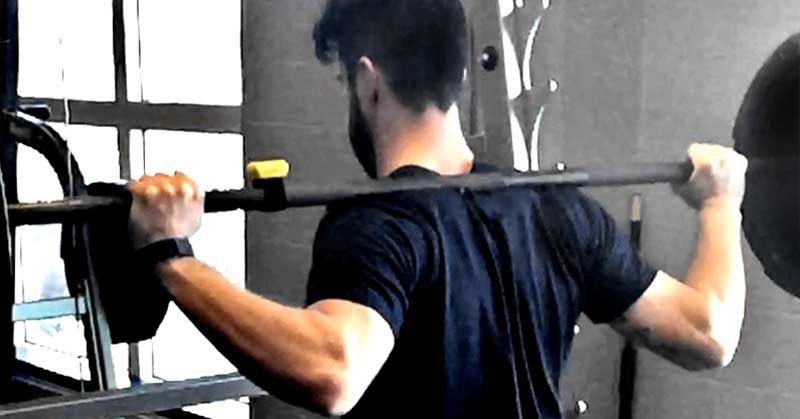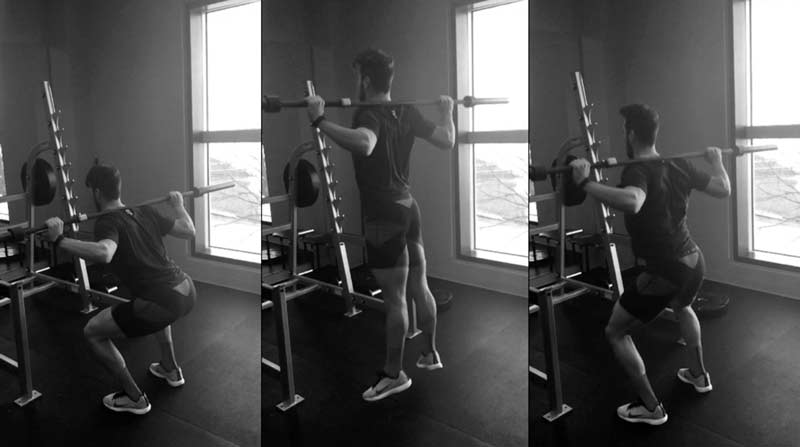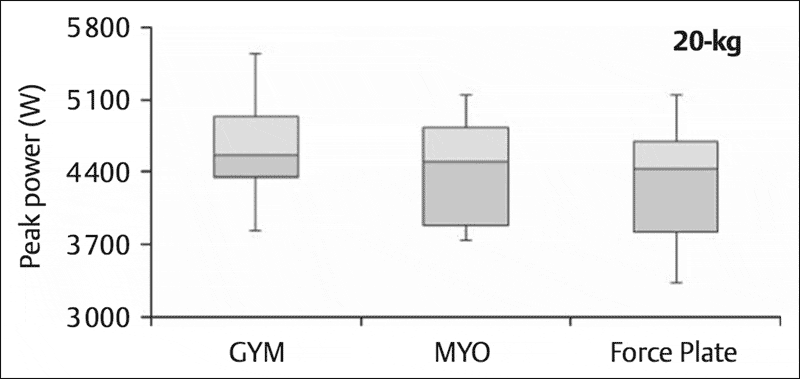
By Carl Valle
Ask a dozen coaches what they do in the weight room for power testing and you will almost certainly get a dozen answers. Most mention something maximal, like a jump or lift. It’s likely that few have heard of the Raptor Test, let along actually put it into practice. I didn’t invent the Raptor Test, but it’s my passion and test of choice in most situations. The beauty of the test is its accessibility and simplicity. Even better, it has a secret benefit— the rich amount of information you obtain by using it every week.
In this article, I will break down the benefits because I already outlined the exercise protocol here. I did discuss some general reasons why I like the test. But the devil is indeed in the details, and it’s wise to know the foundational principles why this test trumps most other options. Some of these time-consuming, expensive, and impractical options may have merit, but the key is data used in the field, not just in 6-week research studies. This is about the need to service strength and conditioning coaches, not live in fantasy worlds.
The name came when I realized doing “countermovement tests” didn’t have the appeal of saying we were doing the “Bosco” tests. When I coined Raptor, some athletes seemed even more interested. Naming a training session with military terms or fighter planes (the F-22) or Jurassic Park dinosaurs is an easy way to get American football players’ attention. Sports medicine likes it because it focuses on fatigue and eccentric abilities, and team coaches get interested because it does indeed show data.
To review, here is the test protocol. Note that this test is designed for teams looking for solid data in a world in which time is precious and the need for applied sport science is high.
- Step 1: Perform 5 separate squat jumps with a barbell (hex or conventional)
- Step 2: Perform 5 separate counter-movement jumps (with bar)
- Step 3: Perform 6-8 continuous elastic jump squats (with bar)
- Step 4: Train lower body or total body power with some decision-making based on the testing data. My suggestion is to train as prescribed, decrease load, or recovery rep ranges and weight. As the season progresses and athletes become more experienced and advanced, the reps needed in Steps 1 and 2 for data integrity can decrease.
Some athletes like warming up with bar complexes while others like squat jumps. The entire process can be part of the warmup, the warm-down, or warmup and training. The test is open, meaning it is flexible based on coaching philosophy and needs analysis.
The test should be done in the squat rack or area where multiple people can train. I like a 1:4 ratio of bars to athletes. You can use conventional Olympic bars or ultra-light teaching barS (less than 15 pounds). Swapping out teaching bars for training bars goes very quickly with groups.
Without delay, here are the big five reasons why strength coaches have fallen in love with doing the basics well.

The Raptor Test is Safe and Simple
Some coaches ask, why not use length versus vertical power? I always explain that landing with long jumps or triple jumps is a mixed bag. I test horizontal jumping with Olympic sports (though not swimmers) but not team sports.
First, landing is a skill that can improve performance but not power. Force plate analysis of some athletes I have worked with reveals moderate improvements from training in the power indices (training changes, no big deal here) and distances improved because they learned to be more aggressive in landing.
Second, I believe in training absorption mechanics, but standing long jump or broad jumping is very specific and not useful for most sports. Testing familiarization will eventually wash out improvements from learning the test, but the nature of the broad jump makes it hard to see different types of contractions (squat jump, countermovement jump, and repeated jump) so I like vertical jumps.
The Raptor Test is a composite of three separate tests sequenced together. That means that each test is valuable by itself but compounds in value over time. I like the test because it is based on other tests we are familiar with, such as the Carmelo Bosco tests. The flow to more ballistic and dynamic motion has progression qualities in the sequence because repeatedly jumping without warming up spooks coaches. I have not seen injuries with vertical testing though one MLS team had a player break his foot (fifth metatarsal) during the preseason. Technically no physical test is risk-free, but I would rather hedge my bets with testing rather than hope for the best and not know what is going on.

The Raptor Test Is Team-Friendly
The Raptor Test is practical for groups, goes quickly, and doesn’t diminish training time. When I coached high school I didn’t have any VBT or force plate options, but now I think it’s possible and a good idea to have a set-up for upperclassmen. Several college coaches can obtain bar speed indices done in groups for each rep; I just want it done weekly or every other week as part of a workout.
Workflow is the name of the game because most good performance programs lose impact in collecting data when the testing has little training effect. There are several reasons for using a training bar (less than 15kg) and a normal 20kg Olympic bar, but the main rationale is that they allow the use of Velocity Based Training sensors. In addition to providing a place to mount the sensor or attach a Linear Positional Transducer, the hands remain in one location, like the protocol for the Bosco tests. Finally, the light load is a gentle reminder that gravity is still present, and the test must be performed with a high effort.

Figure 1. Most teams need a solution that can be done in a conventional weight room, so it’s important that a rack becomes embedded with the pressure sensors or the VBT tool is integrated with the squat rack.
The most important point of the Raptor Test is that it’s “minimally invasive,” meaning it doesn’t interfere with training. Since every coach should have light warmup tests to teach movements and prepare for intense training, it’s a great option for teams trying to get data without losing precious training time.
Just doing vertical jumps is fine, but the most common way of testing is to buy a few contact mats or one force plate and run a lot of athletes through at once. That means long lines and bored athletes. I believe that naked (no-load) jumps are paramount, but that is testing, not training. Raptor Testing with a load does get some small amount of work in, especially with the repeated squat jumps. While it will not make anyone a monster and is not a complete workout, it’s part of one.
Many athletes can be tested quickly because everyone uses the same load. Using the bar by itself means no weight changing, which in turn means faster cycling. Using a universal weight means coaches must be cognizant of how light and weaker athletes respond to a relatively higher load, and conversely how heavy and strong athletes respond to a light load. Still, the key is the speed of testing, and it can be integrated nicely into the training sessions.

The Raptor Test Is Data-Rich
Obviously three tests are going to give you at least three data points. Each jump set offers a series of scores to evaluate. The high frequency of testing allows coaches to see long-term trends. So why is the Raptor Test so “data rich?” The value is mining more information from the relationships of the different jumps when compared, and the details of each rep when drilled down. Here is a short list of areas that can be data-mined with the Raptor Test:
- Comparison of the jump performances over time or a season
- Analysis of each rep performance during a set for athlete profiling
- Evaluation of depth of center of mass during repeated jump squats
- Displaying the Reactive Strength Index-Modified with advanced athletes
- How the Eccentric Utilization Ratio improves or decays during the season
- Revealing the ability to become more elastic with repeated jumping
Obviously we can go on and on with all of the information one can get from testing the simple jump series. Many coaches want more than mean or peak power. For example, a lot of VBT scores are bar-speed summaries, a great guide for reinforcing speed of the movement.
What is missing with a lot of coaching is the deeper analysis—how rapidly is force created or transmitted? Most coaches see the concentric data, but the way the athlete loads and how negative work (eccentric qualities) is interacting is very important. With modern VBT devices, one can get every rep and the force time milestones wirelessly sent to cloud tools and AMS products. Hundreds of quality and unique data points are being captured, and the visualizations required to appreciate what is going on will be the next challenge.

The Raptor Test Is Scientifically Sound
Is the Raptor Test worth it? Its validity is only as good as the adherence to the protocol and procedures, as well as the honest effort of the athlete. The test does have some question marks. Potential areas may make the Raptor Test at risk for false positives and negatives for monitoring, so coaches need to take every round of testing with a grain of salt. I am not saying the Raptor Test has problems with validity or other statistical issues. EVERY TEST has baggage because athletes are more complicated than mere summaries of anatomy and physiology books.
Motivation and arousal with any volitional tests must be factored in. My strongest warning with jump testing is that every data point is bogus if the athlete is not putting in an honest effort since it’s expected that they are maximally trying. Maximal means all-out effort, something hard to achieve with athletes who are lazy, tired, or bored. Buying into the tests is vital, or athletes will simply go through the motions. Pump them up too much and they burn out. Treating the session like a casual training session makes the data unreliable. Coaching is about presence, and I suggest maintaining a strong burn but never get too high or too low to ensure getting repeatable scores.
What value does jump testing have for athletic performance and injury reduction? We see a recent rise (no pun intended) in jump testing, but what must be agreed on is the purpose and value of the data. Jump testing has some relationship with talent though the ability to jump high doesn’t mean one will run fast.

Figure 2. LPT and Accelerometers are good tools for coaches who don’t have access to a force plate, but it’s prudent to see how each model corresponds to a research instrument. The chart above is from 4 years ago (Crewther 2011l) , so it’s important to see how companies update their algorithms and firmware.
In addition to transfer, jump testing may reveal fatigue, but in modern sport schedules its magnitude is unique to each athlete. Some athletes have huge amounts of willpower. When they show up on game day, adrenaline takes over. Some athletes who are tired during testing seem to manifest fatigue in games. The key point here is that the Raptor Test is not comprehensive. Other data sets must give it context, or it’s just interesting jump data.
The construction of the tests has elements that may decrease precision and accuracy when administrating it, but only if athletes are not fit or strong. Using a barbell solves the upper body contribution to the jumps by focusing on leg power, but it does cause some issues with athletes who are not explosive to have poor data relationships if they are too young. College athletes should not have a problem, but a freshman running cross country in high school isn’t going to get much out of this test.
A lot of research on the use of loaded jumps shows that a load will change the force-time characteristics. My only fear is that elastic contributions of the CMJ (countermovement jump) will make barbell use a problem. The solution to this is experience and getting athletes better and sometimes bigger. Body fat is dead weight. Many coaches who worry about the dead weight of the bar interfering with the integrity of the eccentric abilities must realize that 3% extra fat on a linebacker makes a difference as well.
So the smart idea is to look at the tests without a bar and see if the significance matters. I don’t see any problems with the test among explosive athletes in any of the steps. The Raptor Test doesn’t replace the traditional Reactive Strength Index due to specificity considerations, but the RSI-Modified can be done with the Raptor Test with very good outcomes. I like to see10–15% improvement in the scores before I feel something is truly adapting in the body.
Coaches must be looking for data that jumps out at them (again no pun intended) when eyeballing the raw data. While advanced filtering and analysis are important to see minimal worthwhile or true statistical changes, the nature of the test is that we are looking for trends that mean real actionable choices, not something fascinating on podcasts. My problem is trying to see too much meaning in small details, whereas the reality is that I must see the most solid decisions such as training volume or timing of rest. Good goals of the Raptor Test include
- Am I developing more explosive athletes over a part of a career?
- Are we doing the same amount of work but sequencing smarter for better rest?
- Is something in the data showing why our athletes are getting more or less injured?
Of course, longitudinal testing can reveal other questions from coaches and athletes are looking for. Yet the Raptor Test can provide a universal solution such questions.

The Raptor Test Plays Nice with Others
An appealing quality of the Raptor Test is its flexibility and general usefulness. The Raptor Test is vanilla with nothing new being brought to the table, but it represents an applied and modern approach to current sports performance. Many tests are unique to the situation or environment while very few are universal and valuable. The response that I often see with coaches is that it works for them, not that they are finding a way to make it work into their program. The testing doesn’t matter if it’s a small group of athletes training for the Olympics or a large high school trying to manage dozens of athletes.
A Raptor Test can churn out 24 athletes per hour if testing in isolation (lack of equipment) or 24 athletes in 10 minutes with six properly set up sensor stations. Ten minutes may sound like a lot of time, but there is some training effect and also teaching of core movements, such as squatting patterns and jumping motions. The Raptor Test will never intrinsically build monsters, but it helps shape athletes and measure their development.
In closing, coaches may want to use a part of the test and change different elements. That is fine. Nothing wrong with doing a CMJ test every week with the bar for information, as that may not be a Raptor Test. But at least the idea of doing some testing before warming up in the weight room is better than every quarter bringing out the jump mat to get “numbers.”
I have seen some coaches just use the EUR (eccentric utilization ratio) and repeated jump squats to see if their athletes are fatiguing over the set or a series of sets. I don’t like going past eight reps as the athletes tend to pace themselves and this clouds the data. The main theme here is seeing the Raptor Test as a process to get more out of the data and the relationships of multiple bouts of effort rather than “best score” or “mean values.”
Regarding the Culture of the Raptor Test
My parting pearl of wisdom is that all of the above benefits are great. But when it comes down, athletes are athletes and team coaches are team coaches. The strength coach has a responsibility to engage both. I love the Raptor Test because it makes the old new again, especially with technology.
I am not against tests that show loads (max squat or max clean) but I find those too risky politically to base a program on. I find the transfer of heavy loads poor to speed beyond solid numbers like 2xBW or 1.5xBW respectively. Converting to wattage so team coaches see thousands of watts instead of hundreds of pounds creates a fresh look at training and removes the unnecessary addiction to max load as an evaluator of the program.
I suggest using the Raptor Test or making your own series of tests as part of the warming up process. It encourages athletes to train smarter and harder from the instant feedback and long-term development information it provides.
Please share so others may benefit.
[mashshare]

Hi Carl,
Great article. I have a bunch of questions that hopefully you wouldn’t mind answering for added clarity. I am really keen to begin trialling this test.
Squat jump – is this “concentric only” jump? Do you have a recommend knee angle – or would you be led by sport specific relevant joint angles?
CMJ – just to confirm – this is a loaded CMJ with the bar? (just checking there is not a typo).
Elastic jumps – do you have a preferred instruction for the athletes here? “Maximise jump height” or “get off the ground fast”? Or “jump fast AND height”. What are your thoughts?
Have you used this test with the Push Accelerometer device? Any recommendations on key metrics? Would “total work done” in the “workout” be a useful measure alongside PPO in each of the reps?
Good Questions-
Squat Jump- 90 degrees is standard and 100 degrees is also common and some smart people have added some limb measurements and dorsiflexion ROM for more articulation. This is concentric and some systems can detect “dip or drop” for more valid testing.
CMJ- All the tests can be unloaded or loaded, but an ultra-light bar is useful because it keeps the hands uniform and allows for sensors to be added.
Repeated Jump Squats – This is about getting rapid explosions and maximal output without long drop period. Obviously you can decrease ground contact times and do stiffness work, but the reality is one wants to use gravity and some eccentric strength and redirect momentum up. I would look at the RFD at the start of the positive concentric work and see if that is trending up with the same joint angles.
As for instruction I can’t demo what I want so we use youtube and raise the volume of the music. More power and more of the good stuff is our motto. Give me a year and I will be able to see more granularity. Hopefully the community will rise to the problem of trying to refine Carmelo’s work.
Eamonn,
As for equipment the Push Band would be interesting to test. Since you have one why not see what you can get. Anyone else using similar technology try comparing to a force plate or similar?
CV
Thanks for the replies Carl.
I am definitely keen to trial this with push band.
For me, the exciting merit of the Push band is that it could allow for similar type testing to the Raptor test with vastly different exercises to potentially (attempt) to monitor “transfer”. Using the same device across multiple activities could be a big bonus in terms of convenience for coaches (provided its valid and reliable). I could see a similar warm-up / test adding value in team sports such as:
– Squat jump
– CMJ (no load or light dowel)
– Repeated hops
– Max Effort MB Throws
– Max Effort MB Slams
With data all captured on a single device.
Eammon,
One doesn’t need to use the same device, once could technically use Gymaware and the ballistic ball if they need to, along with a SWIFT contact mat. Wifi and Bluetooth make things all connect.
CV
Fully understand that – certainly possible to use multiple devices for optimal breadth of data captured but… I think the potential merit for push is convenience etc from using a single device.
Last question!…..
What physical qualities / adaptation do you think you can gauge from the elastic jump squats that you are not getting from the CMJ? I presume your elastic jump squats are contact time of >.250ms?
Eammon,
Repeated jump squats are using some elastic or stretch reflex, but the contribution is highly based on the following.
Weight of the athlete- Lighter athletes are more reactive and elastic so this part of the test must be interpreted more. 100k plus athletes are less reactive/elastic in general.
Weight of the load- Loads will kill the stretch reflex, but the stronger the athlete and lighter the load the more elastic it will be.
Jump Strategy- Joint angles are based on the talent of the athlete and are highly anatomical and genetic.
Jump Goal- Athletes must be instructed (as you said) to hit time frames.
The .250 time frame is a bit of a mystery but this is why sometimes contact times are great because you can see simple ratios and get good data. Single jumps athletes jump high and land low to inflate numbers, repeated work people don’t do that because of the next jump so landing is about explosive drive versus more hang time.
So I like something around low hurdle hops since the arm contribution is not happening and the time frame is similar to Schmidtbleicher (240-280 ms).
Instruction is always getting up high and fast (like your paper on contact time and SSC for the NSCA)
Also look at the paper below, as I see contact time as good for feedback so long as estimations of RFD or positive net impulse can detected. Eyeballing it possible, but this is binary since a good jump will be rapid, little knee and nearly no ankle motion. The first few reps usually stink because people try to jump like the first two tests, so I have them jump with a shallow start so the rhythm is good. If they go longer remove the bar. I have searched for ultra light bars because when the weight is higher, even talented guys can’t hit those time frames. Very advanced guys can hit the Schmidtbleicher 250 ms but only when they hit more stiffness like techniques.
http://www.ncbi.nlm.nih.gov/pubmed/21873903
I have found no transfer on any of the tests for athletes running faster than 11 meters per second. Most of the info is managing power or injury reduction.